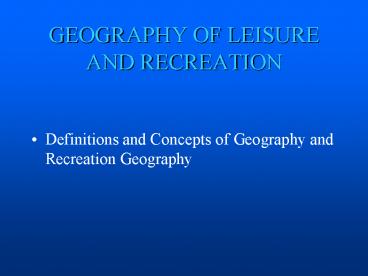GEOGRAPHY OF LEISURE AND RECREATION - PowerPoint PPT Presentation
1 / 23
Title:
GEOGRAPHY OF LEISURE AND RECREATION
Description:
GEOGRAPHY-The study of the spatial distribution of various ... Car Ownership and Presence. Type of Chairlift and Repeat Usage. Employment and Time of Travel ... – PowerPoint PPT presentation
Number of Views:129
Avg rating:3.0/5.0
Title: GEOGRAPHY OF LEISURE AND RECREATION
1
GEOGRAPHY OF LEISURE AND RECREATION
- Definitions and Concepts of Geography and
Recreation Geography
2
GEOGRAPHY-The study of the spatial distribution
of various phenomena on the earths surface
- The emphasis is on location of phenomena
- Where
- Why
3
The question of why brings up linkages to the
usage of the facility Therefore one needs to
explore
- The physical aspects of the site
- The characteristics of the population associated
with the site
Location is a major key to success and
understanding the links between location, site
characteristics, use and population is key to
efficient use of facilities and satisfying the
demands of the population and environment
4
Recreation Geography studies the spatial aspects
of the recreation systemThere are three primary
areas of concern
- Population
- Facilities
- Activity
5
Population
- The size of population in the study area the
impacts on the number, type, and size of
facilities - The characteristics of the population factors
such as age, sex, income, and the use of time
will have influences on the facilities and
activities desired
6
Activities
- Theoretically, the characteristics of the
population will create needs for that population
(or sub-group of the population) - Those needs will generate the motivation
(economic, political, etc) to provide facilities
for the specific activities
7
Facilities
- Facilities provide a site for activities that the
population desires - The facility can generate demand by itself (False
Demand) in the sense of limiting
opportunities - The location is influenced by many demands
8
Assumptions
Studies revolve around
- Location
- Use
- Population, facilities, and activities are
interlinked - There are consequences to the interaction that
occurs between the three factors - These consequences can be understood and
manipulated
9
The Geographic Approach to Problems
- The exploration of spatial arrangement the
distribution of spatial phenomena - The exploration of the relationships between the
factors studied in 1 above - The exploration of spatial process changes in
the factors and relationships that produce
changes in location and usage
10
Spatial Arrangement
- What do you include?
- Therefore have to have a basic idea of what makes
the system work (education, research) - need to have a general working knowledge of the
second approach - gather data, linked to location and
characteristics of the site and users
11
(No Transcript)
12
The Geographic Approach to Problems
- The exploration of spatial arrangement the
distribution of spatial phenomena
2 The explanation of the relationships
between the spatial
phenomena
13
Linkages between Factors
- Attempt to link factors to the facility and the
usage of the facility - Example would be that as expressed in Distance
Decay - As the distance between the population being
considered and the facility increases the
frequency of visit and length of visit changes - Concerns? - linked to need to measure
14
(No Transcript)
15
Factors Possibly Connected
- Age and Use Frequency
- Income and Use Frequency
- Family Size and Babysitting
- Car Ownership and Presence
- Type of Chairlift and Repeat Usage
- Employment and Time of Travel
- Hill Variation and Years Experience
- Apres Ski Facilities and Age
- Gender and Frequency of Use
- Snowmaking ability and Frequency of Use
16
Difficulty of Indirect Relationships
- Assumption that the relationship is direct
people are all knowing and understanding - If there is a relationship with weather and
travel - how do we know the weather in the
destination area? - Are all members of the population affected the
same way?
17
Problem of Simplicity - the one- to-one
relationship
- Distance Decay - the relationship between
distance and frequency of visit. - Are there other factors that influence the
frequency of visit?
- Income
- Employment
- Transportation
- Weather
- Family Relationships
- Facilities on site
18
Spatial Relationships
- Some studies stop at one-to-one relationships
- This does not explain the complexity of the real
relationships - Multiple explanations are better but are
extremely complex - Normally a set point in time is picked so as to
freeze relationships
19
The Geographic Approach to Problems
- The exploration of spatial arrangement the
distribution of spatial phenomena - The exploration of the relationships between the
factors studied in 1 above
- The exploration of spatial process
20
Spatial Process - Change Over Time
- This is a consideration that, in a practical
sense, does not enter into all studies - The previous explanation works because it
freezes the relationships - If a factor changes, the relationships change and
the outcome and linkages change
21
Inertia vs Change
- Facilities are somewhat inflexible - built for
specific activities - People have investment in equipment, training,
skill
- Technologies are not static - changes in
equipment, access, etc - Recreation tends to be fad oriented - therefore
quick changes
22
Prediction
- the relationships are interlinked so all factors
are changing - each might have a different
direction - How do you predict change?
- With the safest method being extrapolation of
current trends - safest prediction period would
be 5 years
23
CONCLUSIONS
- The Geography of Recreation deals with the
location and use of recreation facilities - We need to understand the motivations of
population segments - The end results are a product of multiple
factors, all interacting and all changeable































